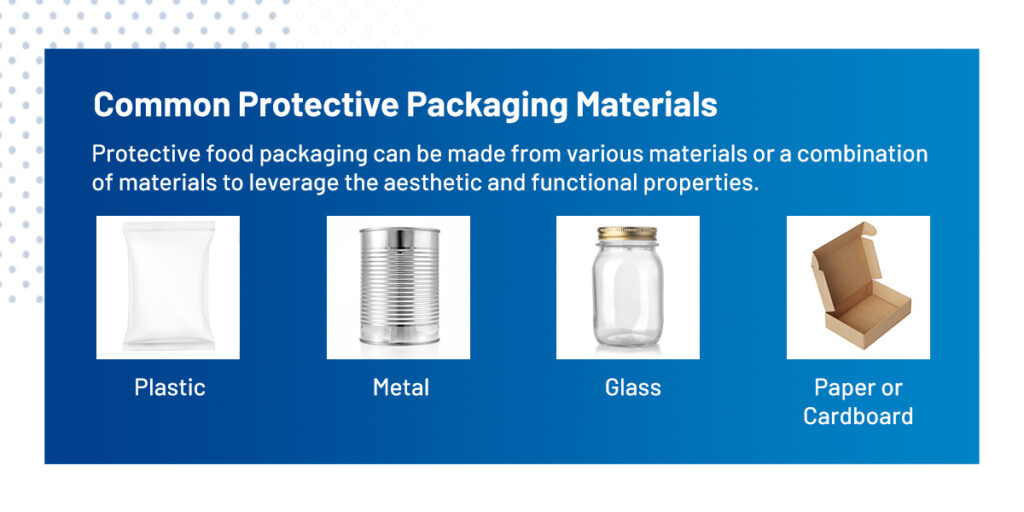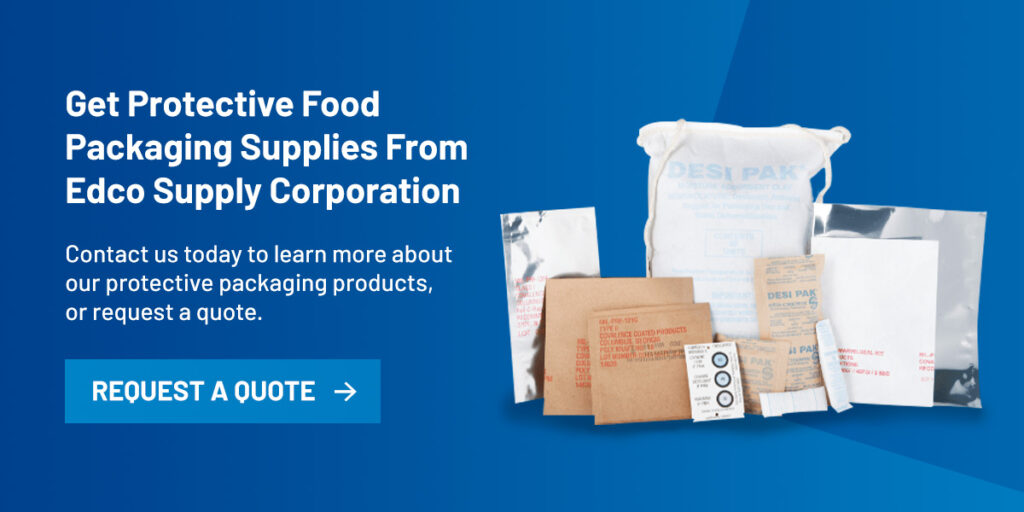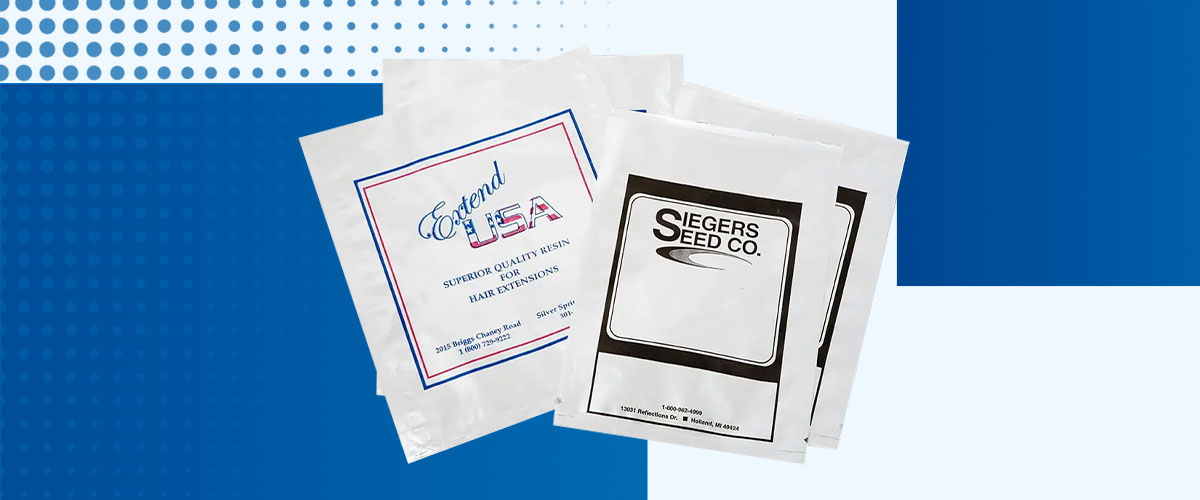Protective packaging refers to the type of packaging materials that enclose, preserve and safeguard contents during storage and distribution. Protective food packaging incorporates techniques like heat sealers and moisture barriers to protect food from contamination and physical damage. They must follow FDA food packaging regulations to ensure that packaging materials do not change the composition, taste or smell of the food.
Protective packaging benefits go beyond protecting food from damage or harm. This article discusses the roles and types of protective food packaging solutions to help you choose the best option for your edible products.
The Primary Role of Food Packing
Food packaging plays numerous roles, mainly protecting the food contents from contamination during storage and transportation. Protective packaging creates a protective barrier against viruses, bacteria, pollutants, mold and other foreign particles that undermine the quality, safety and integrity of the products. Other roles of protective food packaging solutions include:
- Maintain freshness: Protective packaging protects food products from environmental factors like light, moisture and heat that may compromise their freshness and quality. It can help extend their life and preserve beneficial properties by protecting against external chemical and biological factors.
- Prevent physical damage: Substandard packaging leaves your food products susceptible to physical damage during transit and storage. Protective packaging designs and materials absorb vibrations, shocks and crushes that would result in food damage.
- Boost convenience: Convenience features such as microwavable and oven-safe packaging save food prep time. Other convenience features that many consumers appreciate include easy opening, dispensing and resealability.
- Eliminate the risk of tampering: Protective packaging minimizes human contact and facilitates easy handling, storage and usage. Tamper-evident features such as breakaway closures and special membranes make it easy to identify and avoid tampered or contaminated food products.
- Reduce food waste: Protective packaging minimizes food waste by preventing food damage, spoilage and contamination that would lead to throwing out more food. It also helps extend the food’s shelf-life and prolong its usability.
What Kinds of Food Products Need Protective Packaging?
Below, we will discuss some of the most common food products that require protective packaging.
Coffee and Tea
Without a doubt, coffee and tea are some of the most common beverages that people enjoy on a daily basis. Some people use coffee and tea as part of their daily routines, which means if you are a supplier of coffee and tea, you need to make sure you are keeping it dry. Water is essential for making coffee and tea, but when those food products aren’t yet ready to be enjoyed you need to keep them dry. Moisture barrier bags will protect dry food products like coffee and tea until you are ready to send them out or brew them.
Nuts
If you own a business that produces nuts such as almonds, peanuts, and cashews, you definitely need to keep them moisture-free. This type of food is the perfect example of a product that requires moisture barrier bags for storage. The last thing you want is opening up a package of nuts that moisture has penetrated because that typically means you will not be able to sell them.
Spices
Spices can be an expensive food product, which means it is certainly worth keeping in great condition. Moisture barrier bags allow you to keep spices safe and sound from moisture. You can purchase protective packaging like moisture barrier bags in a variety of different sizes to ensure that your spices are safely stored away.
Common Protective Packaging Materials
Protective food packaging can be made from various materials or a combination of materials to leverage the aesthetic and functional properties. The right packaging material depends on the products you’re packaging.

Plastic
Plastic food packaging is popular in the food industry because it’s lightweight, affordable and effective at keeping foods fresh. It’s widely used for packaging wet and dry foods because it can be modified into different shapes, thicknesses and sizes. Plastic can also enhance the protectiveness of other packaging materials like paper and cardboard.
Metal
Aluminum, steel and tin are the most popular materials used for packaging food products. They provide an excellent barrier against environmental factors like moisture, air and light to preserve the quality and integrity of food. Metal is the best material for packaging foods that require high-temperature processing, like canned foods. Being a sustainable packaging solution makes it popular, but some food manufacturers avoid it because it can release chemicals into the food.
Glass
Glass is a protective packaging material with numerous desirable qualities, such as being nonporous and nontoxic. It’s ideal for preserving food and drink flavors, aromas and freshness. Glass packaging can be colored or coated to match your brand’s aesthetics and increase your product’s perceived value. Many manufacturers shy away from glass because it’s breakable and expensive, but benefits like its impermeability, inertness, resistance to extreme temperatures and recyclability make it a worthy investment.
Paper or Cardboard
Paper and cardboard are versatile protective packaging materials. Their appeal stems from the fact that they are biodegradable, compostable and recyclable. They’re easy to brand and customize into different sizes and shapes, ensuring easy handling, storage and transportation. Unfortunately, paper and cardboard don’t offer the same durability, moisture resistance and impact protection as the other protective packaging materials.
Types of Protective Packaging Options
The food industry utilizes military-specified (mil-spec) packaging, enabling safe and secure food transportation and storage. Mil-spec packaging uses materials and characteristics that meet many standards, regulations and codes. Military packaging materials offer the highest level of protection, extend food shelf life and withstand extreme conditions and hazards. They’re highly versatile and customizable to different sizes and shapes that fit specific use cases.
The following are some common forms of mil-spec packaging for the food industry:
Barrier Bags
Barrier packaging bags use a plastic film to protect food products from contamination by specific elements, such as oxygen, light, oils and aromas. Double-layer barrier bags produce robust lamination and can have customized permeability. Moderate and high-performing barrier bags use multiple layers of high-quality plastics to shield contents from odors and visible and UV light.
Moisture Barrier Bags
Moisture barrier bags or vapor barrier bags are made from materials such as polyethylene, paper-backed aluminum, metal or glass sheets. They protect the contents against oxidation, condensation and other moisture-related issues. Moisture barriers in the food industry provide products with longer shelf lives and higher stability and prevent punctures and tears. They’re best used with food products like coffee, tea, nuts and spices.
Desiccant Packs
Desiccant packs are protective packaging that preserves product quality and safety. They contain hygroscopic substances that absorb moisture from the environment to keep foods dry. Silica gel desiccants are the best for food packaging, as they maintain optimal moisture and humidity levels to prevent oxidation and extend the product’s shelf life.
Humidity Indicator Cards
Humidity indicator cards are rigid paper cards that help with moisture control inside food packaging. They contain moisture-sensitive chemical solutions like blue cobalt chloride that rearrange themselves and change color when exposed to moisture. These cards help consumers determine that packaged food products are safe for consumption during purchase or post-storage.
Heat Sealers
Heat sealers create airtight seals that help preserve food freshness and maintain optimal conditions for longer. They involve pressing and melding two layers of thermo-reactive plastics, such as polypropylene (PP), polystyrene (PS), polyethylene and polyvinyl chloride (PVC). They can also enhance the shrink-wrapping process to ensure full enclosure and prevent tampering.
Get Protective Food Packaging Supplies From Edco Supply Corporation
Edco Supply Corporation is the world’s leading supplier of military-specified packaging for the food industry. As reliable food packaging suppliers, we adhere to the highest federal and military compliance standards and offer the fastest lead times. We customize your packaging products based on your material specifications and packaging methods.
Our huge inventory includes different types of protective food packaging, such as barrier bags and film, desiccants, humidity indicator cards, and heat sealers. Contact us today to learn more about our protective packaging products, or request a quote to enjoy great prices for exceptional products.




